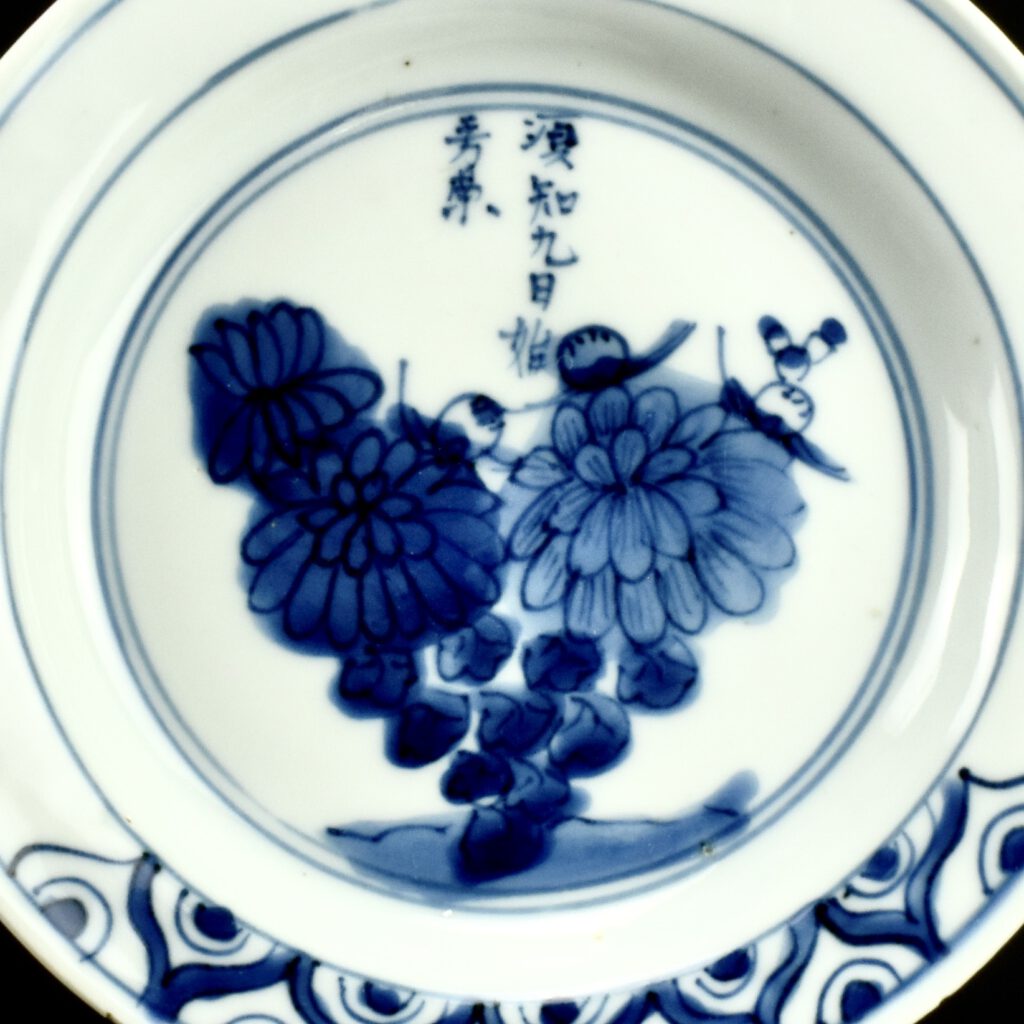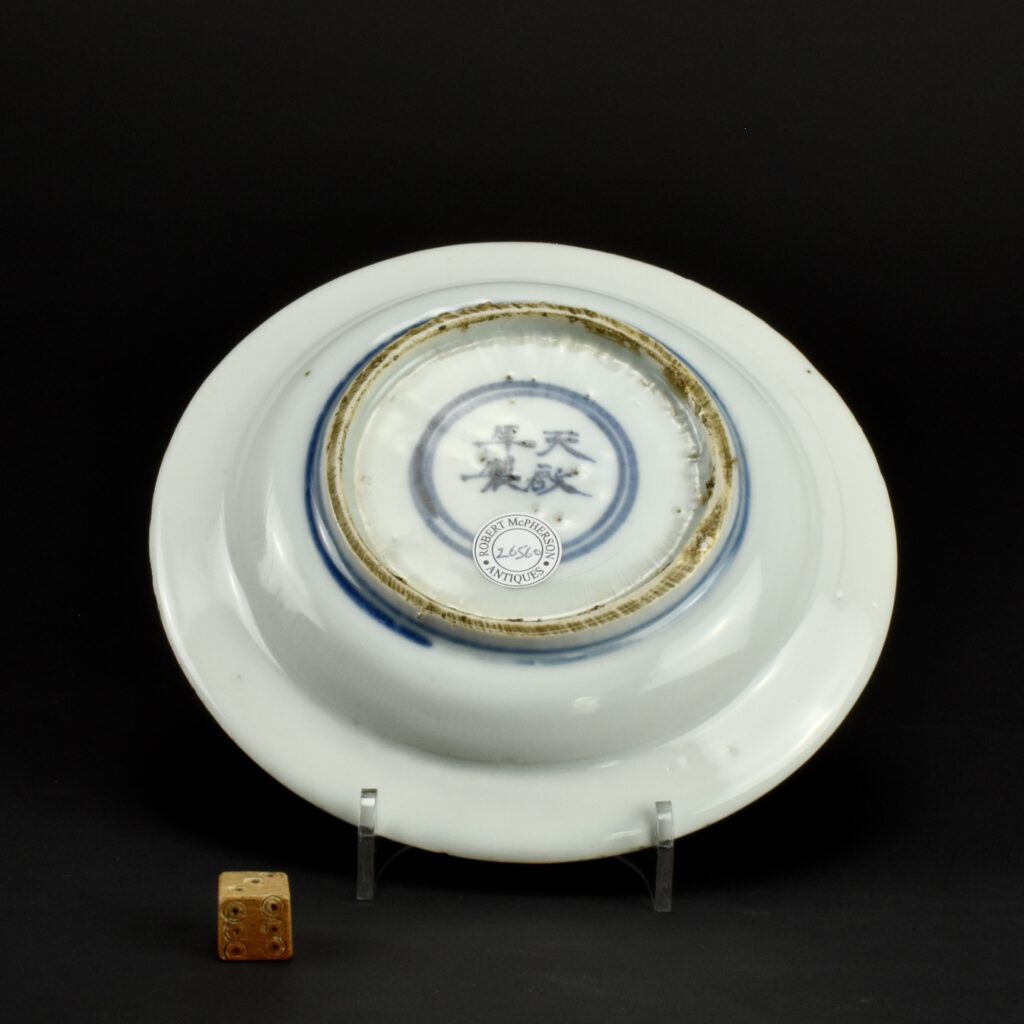
An Inscribed Rare Tianqi Mark and Period Ko-Sometsuke Dish
An Inscribed Rare Tianqi Mark and Period Ko-Sometsuke Dish, Late Ming, Tianqi Period 1621-1627. The center of this small Ko-Sometsuke dish is decorated with double Chrysanthemum, which is mentioned in the inscription. Part of the border is painted with a textile design. The back has a Tianqi Period 1621-1627. The seven character inscription xu zhi jiu ri shi fang rong can be interpreted as ; We must realise that only on the Ninth Day (of the Ninth Month, i.e. on the Double Ninth Festival) does it (the Chrysanthemum) fragrantly flourish. The disintegration of the Ming dynasty during the first decades of the 17th century saw enormous changes in porcelain production at Jingdezhen. Lack of imperial control combined with disinterest in Imperially commissioned porcelain led to a relaxation in the marking of ceramics. Reign marks which could not be used unless for an imperial order were now being used on some non-Imperial porcelain, especially blue and white porcelain made for export to Japan. During the Tianqi period the four character mark of of the period occurs on occasion, but rarely does the six character mark of Tianqi. These marks are non-Imperial, that is to say they are Minyao (popular ware). A similar but larger dish with enamels, the same inscription, is illustrated in ‘Leaping The Dragon Gate. The Sir Michael Butler Collection of Seventeenth-Century Chinese Porcelain’ (Teresa Canepa and Katherine Butler, Ad Ilissvm, ISBN 978-1-912168-16-3. Published in 2021). The Butler Collection dish was sold at Christie’s in Hong Kong on the 29th of November 2021 (see below for more details and a photograph).
See Below For More Photographs and Information.
SOLD
- Condition
- In very good condition, Mushikui (insect-nibbled) rim chips frits, typical of this Ming porcelain made for Japan.
- Size
- Diameter 14.5 cm (5 3/4 inches)
- Provenance
- N/A
- Stock number
- 26560
- References
- Leaping The Dragon Gate. The Sir Michael Butler Collection of Seventeenth-Century Chinese Porcelain' (Teresa Canepa and Katherine Butler, Ad Ilissvm, ISBN 978-1-912168-16-3. Published in 2021). The Butler Collection dish was sold at Christie's in Hong Kong on the 29th of November 2021 (see below for more details and a photograph).
Information
PROPERTY FROM THE BUTLER FAMILY COLLECTION
A RARE ENAMELLED BLUE AND WHITE SAUCER DISH
TIANQI FOUR-CHARACTER MARK WITHIN A DOUBLE CIRCLE AND OF THE PERIOD (1621-1627)
Ko-Sometsuke is a term used to describe Chinese blue and white porcelain made for Japan. This late Ming porcelain was made from the Wanli period (1573-1620), through the Tianqi period (1621 - 1627) ending in the Chongzhen period (1628-1644), the main period of production being the 1620'2 and 1630's. This porcelain made in China for Japanese reflected a rise in interest of the Japanese tea ceremony but it also coincided with the beginning of porcelain production in Japan (from c.1610/20). The porcelain objects produced in China were made especially for the Japanese market, both the shapes and the designs were tailored to Japanese taste, the production process too allowed for Japanese aesthetics to be included in the finished object. Its seems firing faults were added, repaired tears in the leather-hard body were too frequent to not, in some cases, be deliberate. These imperfections as well as the fritted Mushikui (insect-nibbled) rims and kiln grit on the footrims all added to the Japanese aesthetic. These imperfections were something to be treasured by the Japanese, they reflect an imperfect world and the aesthetics of Wabi-Sabi. These 'faults' was an anathema to the Chinese but they went along with it to satisfy the needs of their Japanese customers. The shapes created were often expressly made for the Japanese tea ceremony, especially the meal associated with tea drinking, the Kaiseki. Small dishes for serving food at the tea ceremony are the most commonly encountered form. Designs, presumably taken from Japanese drawings sent to China, these are very varied and often extremely imaginative. They often used large amount of the white porcelain contrasting well with the asymmetry of the design, sometime the Chinese couldn't help themselves but to fill in these gaps with 'excess' decoration. Many other forms were made, among them are charcoal burners, water pots, Kōgō (incense box) as well as variously shaped dishes in the form of fish, fruit or familiar country animals.







.jpg?w=1)
.jpg?w=1)